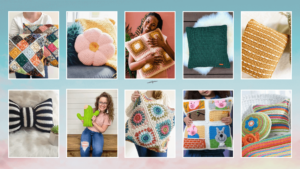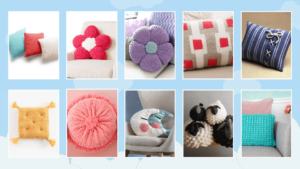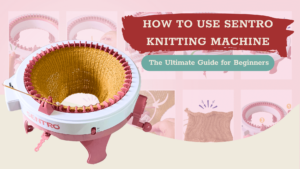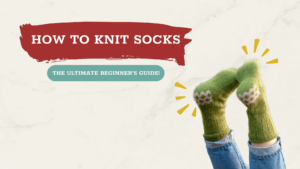How to Knit a Scarf for Beginners: Plus 3 Easy Techniques!
Let's knit the coziest scarf ever!
Let's knit the coziest scarf ever!
Learning how to knit a scarf is a great way to dive in to all the beginner-friendly techniques you need to know as a new knitter! Scarves are not only practical and versatile accessories but also fantastic projects for beginners. Whether you’re looking to create a cozy winter essential or a stylish accessory to complement your outfits, knitting a scarf allows you to get creative and build your skills at the same time.
As a beginner, it’s easy to find tons of knit scarves with very simple patterns. Scarf patterns often rely on basic stitches like knitting and purling, making them accessible even to those who have never picked up knitting needles before. They also are knit back and forth on straight knitting needles, a great place to begin your knitting journey. You can focus on mastering the basic techniques while creating something beautiful and functional.
Look for patterns that use simple stitch combinations, clear instructions, and basic shapes. Keep things simple with a straightforward design and repetitive sections. Lastly, choosing the right yarn and needle size can make a big difference in your knitting experience. We’ll explore some tips for selecting the perfect materials to ensure your scarf turns out beautifully later on in this post!
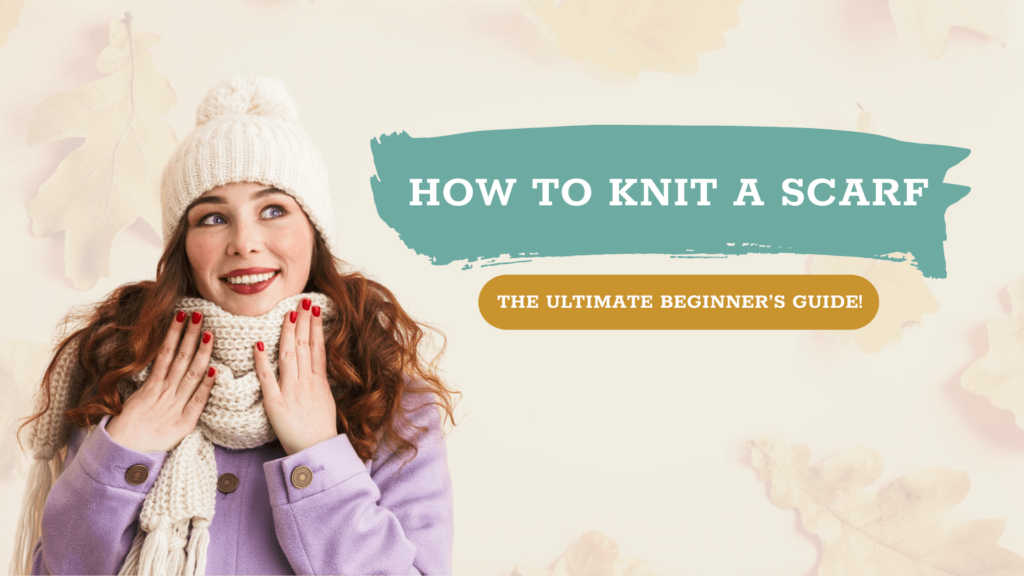
There are all sorts of ways to knit your scarf. Some scarves are knitted using cable stitches, some use the gorgeous fair isle technique, and some have interesting color changes paired with textured stitches.
But for now, we’re sticking to the basics. Today I’m going to give general tips on how to knit a scarf, beginner-friendly stitches, the answer to how long should a scarf be, and other useful info. Let’s cast on and start stitching!
Disclaimer: This article contains links to external unaffiliated websites.
You can’t knit your scarf without the right materials, let’s get you set up with the bare necessities of a basic scarf. Don’t worry, you won’t need a lot!
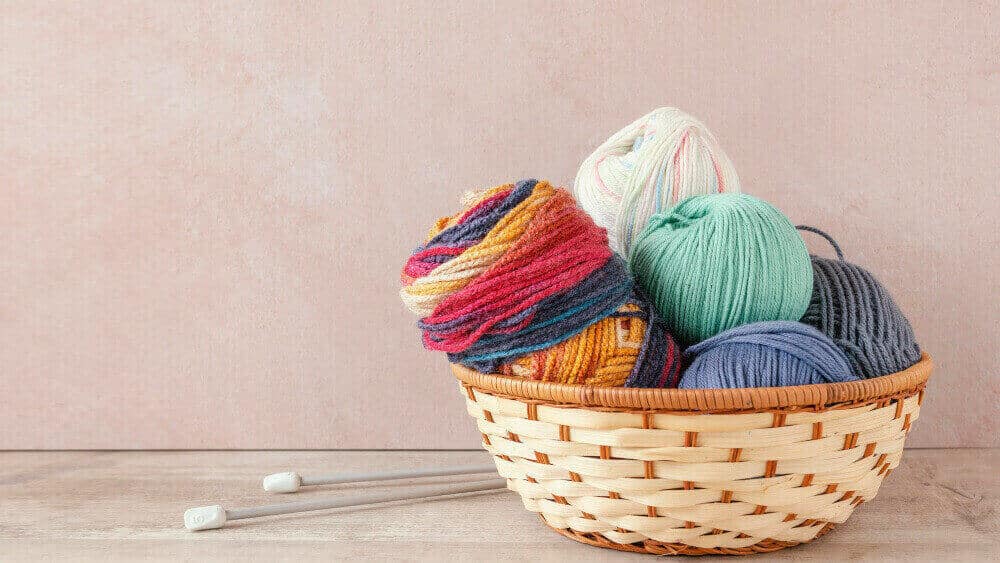
A good scarf should be warm, durable, and comfortable to wear. You can knit a scarf using any fiber type you’d like! A good guideline: try to match the same fiber that the designer used when they wrote the pattern. Some fibers stretch, others are really elastic so matching the types will mean your scarf looks as much like the original as possible. Cheat sheet for yarn types: Acrylic is inexpensive and machine washable, wool is super cozy and bouncy, plant fibers are cool and breathable!
Yarn weight also matters. Thicker yarn weights result in chunky scarves that are quick to finish up. They are also perfect for colder seasons as they have great insulation. Medium or “worsted weight” yarns are perfect for lighter scarves that you can wear during the autumn too.
If you are a beginner, I suggest you go for a yarn weight that is easy to work with. From experience, that would be bulky or worsted weight yarns! About 200g of worsted weight acrylic is enough for a pretty infinity scarf! However, it’s always a good idea to match the yarn weight that the pattern specifies.
Learn more about yarn weights!
Knitting needles come in different sizes and materials. For beginners, I encourage you to use wooden knitting needles. These are easier to work with and prevent your yarn from slipping off! Make sure the size needle you’re using works with the yarn you picked. Ideally, both the yarn weight and needle sizes will match what the pattern recommends.
Learn more about knitting needles for beginners!
Aside from knitting needles, you need other tools to have an easier knitting experience. These are:
Lastly, you need a beginner-friendly scarf knitting pattern. In order for a pattern to be beginner-friendly, it should:
I wrote a more in-depth article all about beginner-friendly knitting patterns. Read all about it here:
FINDING EASY KNITTING PATTERNS: 10+ FREE ROUND UPS!
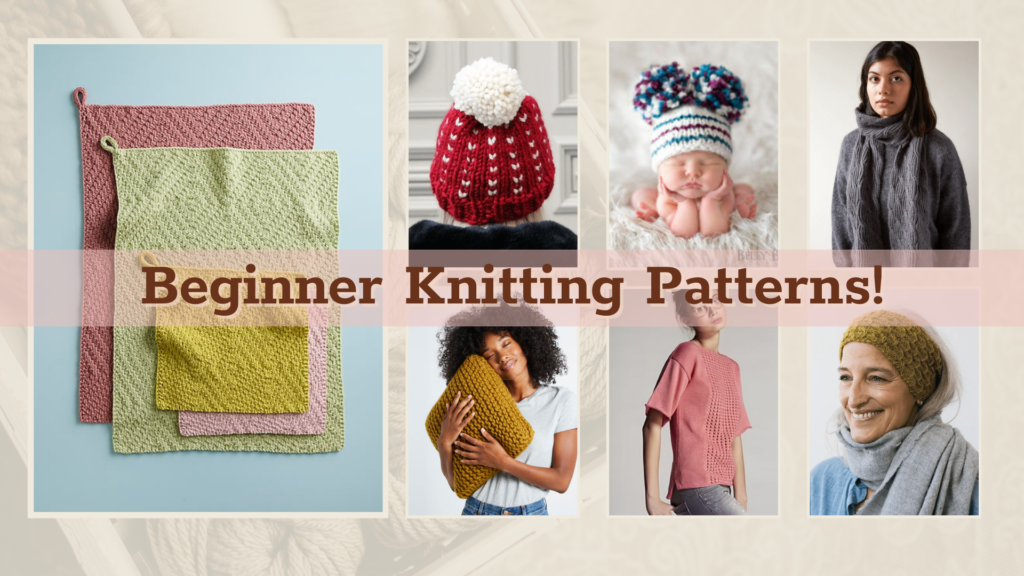
Basic knitting stitches are all you have to worry about while you’re learning how to knit a scarf. You only need to know one cast on method, one to two basic knitting stitches, and one cast off method. Easy, right?
So for this portion of the article, let’s talk about the easiest and most beginner-friendly stitches for you to use!
The thing about scarves is that they don’t need a fancy cast on. You just need a cast on that is sturdy and easy to work with! Here are my top two favorite cast-ons for simple knit edges:
Basic Knitted Cast On
The basic knitted cast on creates a sturdy edge that has a small amount of stretch and can be used on other fun knitting projects like dishcloths, cowls, and yes, SCARVES!
This cast on also introduces you to the knit stitch in the most beginner-friendly way ever.
The Backward Loop Cast On
The Backward Loop Cast On is another favorite of mine because it’s the easiest cast on method you can learn! It uses only one needle and creates a neat sturdy edge for you to work on.
This cast on method is excellent for learning how to knit anything because you can get familiar with the common hand motions involved in knitting!
Learn More Cast On Techniques!
You can make the ultimate cozy scarf with just the basic knitting stitches. My go-to simple knitting stitches are the Garter Stitch and Rib Stitch! Let’s talk about them:
Garter Stitch
The Garter Stitch is an easy, beginner-friendly stitch well-loved for it’s simplicity, texture, and satisfying squishiness! It’s incredibly durable and elastic — perfect for many knitted projects.
You can use this stitch to make cozy blankets, dishcloths, and chunky scarves!
Rib Stitch
The Rib Stitch is a type of stitch pattern achieved by alternating the knit stitch and purl stitch in the same row or round. It’s a popular stitch pattern used to knit beanie brims, sweater cuffs, and other wearable knits that need stretchy hems!
Stockinette Stitch
If you want to knit a flat fabric, the Stockinette Stitch is what you’re looking for. This stitch pattern is created by alternating the knit stitch in one row and purl stitch in another.
Just bear in mind that stockinette edges tend to curl up. This is caused by the differences in tension between the knit stitches and purl stitches. You can remedy this by creating a garter stitch or rib stitch edge!
Once you’re satisfied with the length of your scarf, it’s time to bind off your work! Binding off takes the project off your needles and finishes the edge at the same time so that your stitches don’t unravel!
Different bind off techniques yield different results in terms of sturdiness, appearance, and elasticity. If you are learning how to knit a scarf, a nice, sturdy edge is all you need!
Here are the easiest bind off techniques that I absolutely love using in many of my own knitting projects:
Basic Knitted Bind Off
The Basic Knitted Bind Off is one that I frequently use for most of my flat knits. It’s a type of bind off that uses similar hand movements to the knit stitch and is VERY easy to do!
Pro Tip: Use wooden knitting needles for casting off to help keep the stitches on the needles while you work, no dropped stitches at the last minute for us!
I-Cord Bind Off
Looking for a pretty edge? The I-Cord Bind Off creates a sturdy, round edge on your project resulting in a neat and polished finish.
Learn More Bind Off Techniques!
Learn more amazing stitches from our tutorial playlist below:
I’m sure you have other questions like “how long should a scarf be?” or “how do I make sure that my finished product looks like the photo?”. Well, we’re answering them here!
Running out of yarn can be frustrating, especially for beginners who are just learning how to knit a scarf. But adding yarn or switching colors is much easier than you think!
There are a few ways to join new yarn into your work. But our favorite is the Magic Knot. I made sure to attach an easy-to-follow tutorial below:
It’s normal to follow a knitting pattern if you are just learning how to knit a scarf. These patterns typically have a knitting gauge noted at the top. Gauge is the number of stitches per inch in the finished fabric. We use this measurement so that knitters can match the designer’s tightness and achieve similar results.
We have a more in-depth tutorial on how to perform a gauge check. So make sure to check it out here:
Scarves are typically about 60 to 80 inches long. You want a scarf that you can comfortably wrap and secure around your neck and shoulders so you can keep your hands free to do whatever you want on your day out!
Finished knitting your scarf? Awesome! It’s finally time to add some final touches. You want a scarf that you can wear out and not worry about unravelling after the first use. Your scarf should also look how you want it to look. Let’s talk about how to weave in your yarn ends, blocking, and spicing up your scarf.
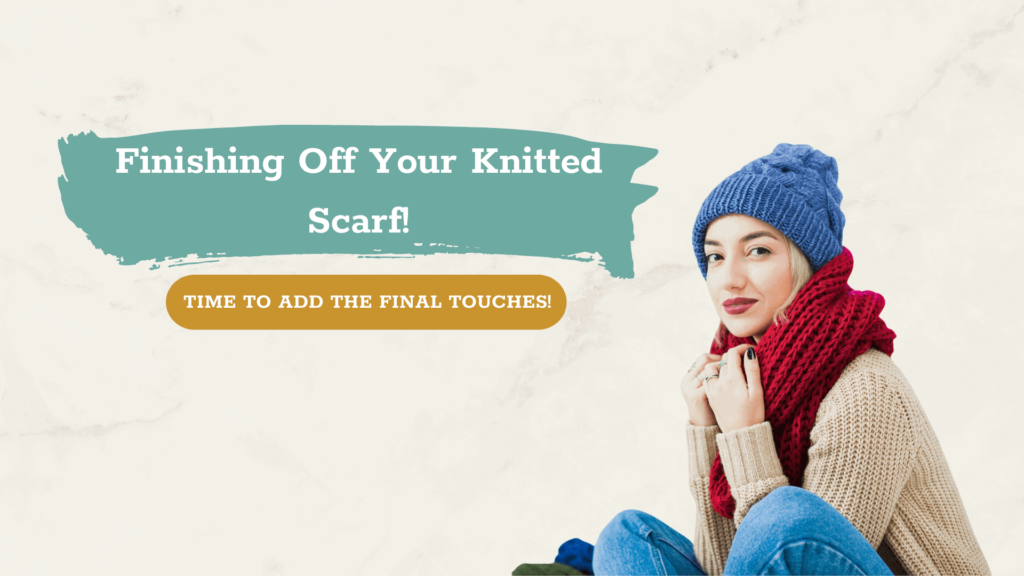
Once you’re done knitting your scarf, it’s time to weave in your yarn tails! Weaving in your yarn tails secures your edges and stops your work from unravelling.
It’s quite easy to weave in your ends. All you need is a darning needle, scissors, and this very beginner-friendly tutorial below!
Want that straight, crisp edge in your knits? Then it’s time to block your work! Blocking your work removes the warping that typically occurs during the creation process. This is also a great way to improve the way wearable fit and lay on your body!
This step is completely optional and isn’t exactly necessary for all projects. But it sure does make for some pretty knits! This involved using blocking pins or blocking combs and a blocking board.
There are two popular ways to block your work:
Steam Blocking is when you pin your work in position and running a clothes steamer over the top to slightly dampen the fabric and allowing it to dry in place.
This method is great for knits that don’t need to be washed often.
Wet Blocking is when you fully saturate your knits with water either by giving it a soft wash in a basin or spraying it with water. Then gently squeezing the water out using a dry towel and laying/pinning it flat to dry.
This method is perfect for wearables like knit dresses, sweaters, cardigans, and scarves!
Learn How to Block Your knits!
Attaching some fringe to the edge of a knitted project is a good way to spice things up. It’s easy, quick, and can give your knitted scarf a unique look. Here’s a tutorial by Pattymac Makes on YouTube:
Scarves are amazing projects for beginners thanks to the shape of the fabric and the repetitive nature of the stitches. Yes, even with just the knit stitch and purl stitch, you can create a beautifully cozy knit scarf!
This was quite a long article and it can be overwhelming to digest everything in one go. But we’re all crafters here! We’re all too familiar with how long it can take to learn and get better at a craft. Don’t feel like you need to be able to knit a new, perfectly knitted scarf after your first attempt.
Practice your newly found knowledge by trying other scarf knitting patterns. Check out these free beginner-friendly scarf patterns:
You don’t always need knitting needles to knit! Here are other ways to knit a scarf!
